The Guitarist’s Guide To Blues Harmony and Forms
Blues music is not just a genre of music. It’s a timeless journey into the depths of human emotion, resonating with guitarists across generations. From the smoky juke joints of the Mississippi Delta to the bustling streets of Chicago and beyond, blues guitar has left an indelible mark on the musical landscape.
In this guitarist’s guide, we will take a peek into the 12-bar blues progression, explore other standard forms and styles, dissect blues harmony, examine common chords used in blues, and provide recommendations for essential listening to inspire and inform your blues guitar journey.
Down at the Crossroads: The Origins of the Blues
The birth of blues harmony traces its roots to the late 19th and early 20th centuries, nestled deep within the vibrant African American communities of the southern United States, particularly the hallowed grounds of the Mississippi Delta.
A profound musical fusion took shape amidst the sweltering heat and the echoes of cotton fields. Blues harmony emerged as a potent amalgamation of African rhythmic traditions, European harmonic concepts, and the soul-stirring cadences of work songs and spirituals.
Initially forged on the anvil of simplicity, blues harmony found its voice through elemental chord progressions like the timeless I-IV-V. Yet, as the blues journeyed through the corridors of time, it embraced new influences with open arms. From the smoky jazz clubs of New Orleans to the hallowed halls of gospel choirs, blues harmony evolved, absorbing the rich tapestry of musical styles surrounding it.
Today, blues music is a testament to the resilience of the human spirit, a living embodiment of the trials and triumphs of past generations. It remains a vibrant thread woven into the fabric of various blues styles, its echoes reverberating across continents and cultures, shaping the musical landscape with its timeless allure.
Tension and Release: A Cornerstone of Blues Harmony
Tension and release are not just musical concepts but emotional touchstones that define blues music’s vibrant tapestry. Embedded within the very fabric of blues harmony, they wield immense power, captivating listeners and stirring souls.
Blues harmony, rooted in fundamental elements of music theory such as scales, chords, and progressions, thrives on the interplay between tension and release. Here’s a closer look at how these elements intertwine:
Blues Scale
At the heart of blues harmony lies the blues scale, a six-note masterpiece blending major and minor tonalities. With its signature “blue note,” this scale imbues blues melodies with a haunting allure, evoking raw emotion and deep resonance.
Minor Blues Scale: Position 1
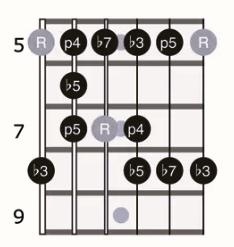
Minor Blues Scale: Position 2
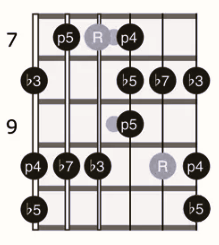
Minor Blues Scale: Position 3
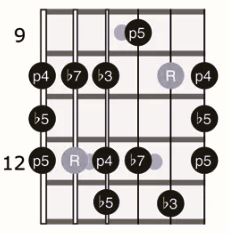
Minor Blues Scale: Position 4
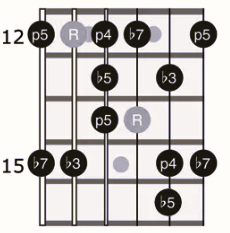
Minor Blues Scale: Position 5

Major Blues Scale: Position 1
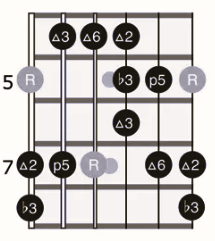
Major Blues Scale: Position 2

Major Blues Scale: Position 3
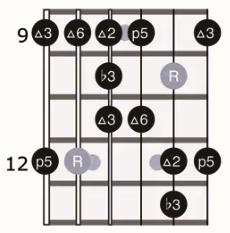
Major Blues Scale: Position 4
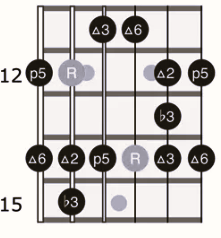
Major Blues Scale: Position 5

Pentatonic Scales
Alongside the blues scale, pentatonic scales are key players in blues harmony. Their simplicity belies their versatility, offering a concise yet potent arsenal of notes for crafting soulful melodies and impassioned solos.
To learn more, check out our guide to Learning the 5 Pentatonic Scale Patterns on Guitar.
Dominant Chords
Dominant 7th chords are foundational to blues harmony, bearing the weight of tradition and the grit of authenticity. With their distinct blend of tension and resolve, these chords provide the backbone of blues progressions, infusing the music with its characteristic bluesy charm. Moreover, advanced blues harmony often sees the incorporation of extended chords like the 9th and 13th, enriching the harmonic palette with depth and complexity.
Chord Progressions
The iconic 12-bar blues progression is a testament to the enduring allure of blues harmony. Its cyclical nature offers a canvas for musical storytelling, with each chord change guiding the listener through a journey of tension and release. From the brooding depths of the tonic chord to the triumphant ascent of the dominant, each progression evokes a kaleidoscope of emotions, painting a vivid portrait of the human experience.
Turnarounds
In a blues song, turnarounds are pivotal moments of tension and release. These brief, cyclical progressions are emotional signposts, marking the transition between verses and choruses. With their judicious use of dominant 7th chords and chromatic passing tones, turnarounds heighten anticipation and release, lending a sense of drama and urgency to the music.
In essence, blues harmony is a tapestry woven with threads of tension and release, each chord changes a brushstroke in a masterpiece of emotion. By mastering these fundamental principles, musicians unlock the soulful essence of blues music, creating performances that resonate deeply with audiences and stand the test of time.
Understanding the 12-Bar Blues Progression
At the heart of blues music beats the pulse of the 12-bar blues progression, a timeless structure that serves as the very essence of the genre. Anchored by three foundational chords—the I, IV, and V—the 12-bar blues unfolds over a span of 12 bars in a sequence that resonates with soul-stirring familiarity.
For instance, in the illustrious key of A, the progression dances along a path adorned with chords like:
A7 | D7 | A7 | A7 | D7 | D7 | A7 | A7 | E7 | D7 | A7 | E7
Yet, within this seemingly rigid framework lies a world of boundless creativity and expression. The beauty of the blues lies in its structure and inherent flexibility, offering musicians a canvas upon which to paint their sonic tapestries.
Musicians find room to roam, explore, and innovate in this hallowed form. Through subtle substitutions and daring embellishments, they breathe life into the progression, infusing it with hues of color and depths of emotion.
Minor variations, such as the inclusion of dominant 9th or 13th chords, serve as brushstrokes on this canvas, adding layers of complexity and nuance to the musical landscape. In the hands of skilled practitioners, these deviations from tradition transform the progression into a living, breathing entity—a reflection of the human experience in all its raw beauty and complexity.
Thus, while the 12-bar blues progression may serve as a roadmap, it takes on a life of its own in the hands of a capable guitar player, becoming a vessel for self-expression that brings the blues to life.
Check out this YouTube playlist to learn how to get started with playing the 12-bar blues progression using dominant 7th chords.
Exploring Other Blues Forms and Styles
While the 12-bar blues serves as a foundational element of blues music, it represents just one facet of the genre’s diverse landscape. From the evocative melodies of Delta blues to the dynamic energy of Chicago’s urban blues and the rhythmic vitality of Texas blues, the spectrum of blues styles is vast and compelling.
Take, for instance, the 8-bar blues—a condensed iteration of its 12-bar counterpart. Its brevity imbues it with a sense of urgency and intensity, delivering a powerful impact.
In contrast, the 16-bar blues unfolds as a spacious canvas, allowing for extensive exploration and development of melodies. With its expanded structure, this form encourages musicians to traverse intricate harmonic territories, crafting elaborate musical narratives with each chord progression.
Whether immersing oneself in the raw authenticity of Delta blues or embracing the vibrant pulse of Chicago’s urban scene, each blues form offers a unique sonic palette and abundant expressive opportunities. Engaging with these varied styles not only enhances our appreciation of blues music but also strengthens our connection to its enduring charm.
If you’re in the mood for dancing, check out our course Intro to Blues Guitar: Boogie Woogie.
10 Blues Standards Every Guitarist Should Learn
There are countless essential blues songs that every guitar player should know, as they offer valuable insights into blues guitar techniques, styles, and improvisation. Here are some iconic blues songs that have shaped the genre and continue to inspire guitarists worldwide:
- “Crossroads” by Robert Johnson: This seminal blues classic showcases Johnson’s mastery of slide guitar and intricate fingerpicking. The song’s haunting melody and evocative lyrics make it a must-know for any blues guitarist.
- “Sweet Home Chicago” by Robert Johnson: Originally recorded by Robert Johnson, “Sweet Home Chicago” has become a blues standard, covered by countless artists over the years. Its infectious groove and timeless lyrics make it a staple of blues repertoire.
- “Stormy Monday” by T-Bone Walker: Often referred to as the “blues national anthem,” “Stormy Monday” features T-Bone Walker’s smooth guitar playing and soulful vocals. The song’s sophisticated chord changes and emotive phrasing make it a favorite among blues guitarists.
- “The Thrill is Gone” by B.B. King: “The Thrill is Gone” is a signature song by B.B. King, showcasing his distinctive vibrato and expressive playing style. With its soulful melody and heartfelt lyrics, this blues standard remains a cornerstone of the genre.
- “Texas Flood” by Stevie Ray Vaughan: Stevie Ray Vaughan’s electrifying rendition of “Texas Flood” is a tour de force of blues guitar virtuosity. His fiery solos and dynamic playing breathe new life into this blues classic, solidifying its place in the pantheon of essential blues songs.
- “Red House” by Jimi Hendrix: Jimi Hendrix’s “Red House” is a blues-rock masterpiece featuring his incendiary guitar work and soulful vocals. The song’s gritty tone and improvisational sections make it challenging yet rewarding for guitarists to learn.
- “Born Under a Bad Sign” by Albert King: Albert King’s “Born Under a Bad Sign” is a quintessential blues song known for its iconic guitar riff and powerful vocals. The song’s minor key and driving rhythm make it a standout in the blues canon.
- “Hoochie Coochie Man” by Muddy Waters: Muddy Waters’ “Hoochie Coochie Man” is a classic Chicago blues tune featuring his gritty vocals and stinging guitar licks. The song’s swaggering groove and infectious energy make it a favorite among blues enthusiasts.
- “Statesboro Blues” by Blind Willie McTell: Originally recorded by Blind Willie McTell and later popularized by The Allman Brothers Band, “Statesboro Blues” is a high-energy blues romp with a driving slide guitar riff. Its infectious energy and raw intensity make it a staple of blues jam sessions.
- “I’m Tore Down” by Freddie King: Freddie King’s “I’m Tore Down” is a classic blues shuffle with a catchy melody and irresistible groove. The song’s infectious rhythm and dynamic guitar solos make it a favorite among blues guitarists.
These are just a few essential blues songs that every guitar player should know, but the blues genre is vast and diverse, with countless other gems waiting to be discovered. Exploring these songs and learning from the masters is essential to developing as a blues guitarist and embracing the rich tradition of the blues.
Interested in Blues Guitar Lessons?
Ready to dive deeper into the world of blues guitar? Whether you’re just starting out or looking to refine your skills, Green Hills Guitar Studio is your destination for top-notch blues guitar lessons.
Our experienced instructors are passionate about helping you master the techniques and nuances of blues guitar playing.
Join us in Nashville for personalized one-on-one lessons tailored to your level and goals, or connect with us online from anywhere in the world. Whether you’re eager to learn the iconic riffs of blues legends or want to develop your improvisational chops, we’re here to guide you every step of the way.
Take advantage of the opportunity to unleash your inner blues guitarist. Contact Green Hills Guitar Studio today.






